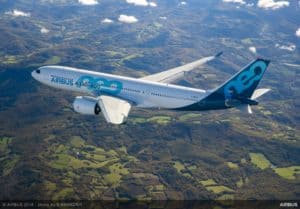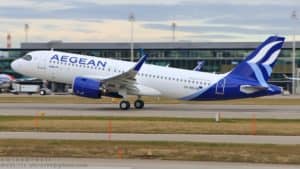The Airbus A-330 and the Airbus A-320 are both mid-sized, narrow-body airliners that are manufactured by Airbus. They both have a seating capacity of around 220 passengers, and they both feature a two-class cabin layout.
However, there are some significant differences between these two aircraft. In this article, we will take a look at the specifications and features of the Airbus A-330 and the Airbus A-320 to see how they compare.
| Aircraft: | Airbus A330-800neo | Airbus A320neo |
|---|---|---|
| Photo: |
 |
 |
| Country: | France | France |
| Manufactured: | from: 2015 to: Present | from: 2014 to: Present |
| ICAO: | A338 | A20N |
| Price: | $259.9 million | $110 million |
| Avionics: | - | - |
| Engine: | 2x Rolls-Royce Trent 7000-72 | 2x Pratt & Whitney PurePower PW1100G-JM / CFM International’s LEAP-1A |
| Engine Type: | Turbofan | Turbofan |
| Power: | 72,834 horsepower | 27,120 pound-force |
| Max Cruise Speed: |
496 knots 919 Km/h |
473 knots 876 Km/h |
| Approach Speed (Vref): | - | - |
| Travel Range: |
8,150 Nautical Miles
15,094 Kilometers |
3,400 Nautical Miles
6,297 Kilometers |
| Fuel Economy: | - | - |
| Service Ceiling: | 41,450 feet | 39,800 feet |
| Rate of Climb: | - | - |
| Take Off Distance: |
2770 metre 9,087.82 feet |
1951 metre 6,400.84 feet |
| Landing Distance: | - | - |
| Max Take Off Weight: |
250,840 Kg 553,002 lbs |
79,015 Kg 174,196 lbs |
| Max Landing Weight: |
186,000 Kg 410,056 lbs |
67,400 Kg 148,590 lbs |
| Max Payload: |
43,998 Kg 96,998 lbs |
20,000 Kg 44,092 lbs |
| Fuel Tank Capacity: |
36,740 gallon 139,076 litre |
7,060 gallon 26,725 litre |
| Baggage Volume: | - |
37 m3 1,307 ft3 |
| Seats - Economy: | 257 seats | 194 seats |
| Seats - Business Class: | - | - |
| Seats - First Class: | - | - |
| Cabin Height: | - | - |
| Cabin Width: |
5.26 metre 17.26 feet |
3.7 metre 12.14 feet |
| Cabin Length: |
45 metre 147.64 feet |
27.51 metre 90.25 feet |
| Exterior Length: |
58.82 metre 192.98 feet |
37.57 metre 123.26 feet |
| Tail Height: | 11.76 metre - 38.58 feet | 11.76 metre - 38.58 feet |
| Fuselage Diameter: |
5.64 metre 18.50 feet |
3.95 metre 12.96 feet |
| Wing Span / Rotor Diameter: |
64 metre 209.97 feet |
35.80 metre 117.45 feet |
| Wing Tips: | Other | No Winglets |
| More Info: | Airbus A330-800neo | Airbus A320neo |
|
Data presented is for entertainment purposes and should not be used operationally.
|
Other Airbus A330-800neo comparisons:
Other Airbus A320neo comparisons:
Airbus A320
The Airbus A-320 is a popular narrow-body jetliner that first entered service in 1988. It is notable for its use of fly-by-wire technology, which reduces pilot workload and increases safety. The A-320 is highly fuel-efficient, thanks to its CFM56 engines.
The aircraft has a range of approximately 3,700 kilometers, making it ideal for short to medium-haul routes. As of 2019, over 8,500 A-320s have been delivered to over 400 operators around the world.
The A-320 has been involved in several high-profile accidents, but its safety record is generally good.
With its proven reliability and low operating costs, the A-320 is likely to remain a popular choice for airlines for many years to come.
Why was the Airbus A320 developed?
The Airbus A-320 was developed by the European aviation industry in response to the growing demand for a new generation of fuel-efficient aircraft.
The A-320 was designed to be a highly efficient aircraft, with some features that help to reduce fuel consumption. These include its advanced wing design, which provides good aerodynamic performance, and its lightweight construction, which uses composite materials in key areas such as the fuselage and wings.
The A-320 also has an excellent maintenance record, with an average time between required maintenance checks of just over 12 months. This is significantly lower than the average for other types of aircraft.
What purpose does the Airbus A320 serve in the aviation industry?
The Airbus A-320 is a popular choice for airlines and passengers alike. It is a workhorse of the skies, with a range of up to 3,700 nautical miles and the ability to carry up to 186 passengers.
With its fuel-efficient engines and advanced aerodynamics, the A-320 is one of the most fuel-efficient aircraft in its class. It also has a wide variety of safety features, including an enhanced flight control system that helps to prevent stalls.
As a result, the A-320 is well-suited for short-haul and medium-haul routes. And with its low operating costs, it is an attractive option for budget airlines.
Airbus A330
The Airbus A-330 is a wide-body aircraft with a twin-engine layout. It was originally designed as a long-range passenger liner but has since been adapted for use as a freighter, military transport, and air tanker.
The A-330 has a wingspan of 60 meters and a length of 63 meters. It has a maximum takeoff weight of 233 tonnes and can carry up to 335 passengers. The A-330 is powered by two turbofan engines, each of which generates up to thrust. It has a cruising speed of 860 kilometers per hour and a range of 13,700 kilometers.
The A-330 is manufactured by the Airbus Company and is currently in service with over 60 airlines around the world.
Why was the Airbus A330 developed?
The Airbus A-330 was developed by the European aviation industry as a response to the Boeing 747. The 747 was a significantly larger aircraft than anything that had come before it, and it represented a significant leap forward in technology.
The A-330 was designed to be a competitor to the 747, offering similar capabilities but at a lower cost. The A-330 has been widely successful, and it is now one of the most popular aircraft in the world.
Thanks to its size, range, and fuel efficiency, the A-330 has become a staple of the global airline industry.
What purpose does the Airbus A330 serve?
The Airbus A-330 is a wide-body twin-engine jet airliner that is commonly used for long-haul flights. It’s a popular airline choice because it is fuel efficient and has a low operating cost.
The A-330 is also versatile and can be configured to seat anywhere from 210 to 440 passengers. In addition, the A-330 has a range of 7,200 to 8,000 nautical miles, which makes it well-suited for flights between Europe and North America.
As a result, the A-330 plays an important role in the European aviation industry by providing a reliable and cost-effective option for long-haul flights.
Differences Between Airbus A330 & Airbus A320
The Airbus A330 is a wide-body aircraft whereas the Airbus A320 is a narrow-body aircraft. Therefore, the A330 has a wider fuselage which can accommodate more passengers and cargo than the A320.
The A330 also has a longer range than the A320, meaning it can fly for longer distances without stopping to refuel. In terms of engines, the A330 has two engine options: either two Rolls-Royce Trent 700s or two General Electric CF6-80E1s.
The A320, on the other hand, can only be powered by two CFM International CFM56 engines. Finally, the A330 is equipped with a fly-by-wire control system while the A320 has a more traditional mechanical control system.
These are just some of the major differences between these two popular aircraft models from Airbus.
Similarities Between Airbus A330 & Airbus A320
The Airbus A-330 and the Airbus A-320 are two popular jetliners that share many similarities.
For example, both aircraft are members of the Airbus A320 family and share a similar fuselage design. In addition, both planes are powered by twin engines and have a similar range. However, there are also some notable differences between the two aircraft.
The A-330 is a wide-body plane while the A-320 is a narrow-body plane. The A-330 also has a longer range than the A-320 and can carry more passengers and cargo.
Despite these differences, the A-330 and the A-320 are highly efficient jetliners that offer a smooth and comfortable flying experience.
Airbus A330: The Better
The Airbus A-330 is a wide-body airliner produced by Airbus. Launched in 1987, the A330 was one of the first aircraft to use composite materials for its fuselage and wings. This made the A330 lighter and more fuel efficient than its predecessor, the A300.
The A330 also has a longer range than the A300 and can carry more passengers and cargo. The A330’s fly-by-wire controls make it easier for pilots to fly, and its high-tech cockpit includes a Heads-Up Display (HUD), which projects information onto the windshield so that pilots can keep their eyes on the runway during landing.
The A330 is also equipped with an Emergency Location Transmitter (ELT), which broadcasts a signal to rescue crews in the event of a crash.
Overall, the Airbus A-330 is a more advanced and capable plane than the Airbus A-320, making it the better choice for long-range travel.
Airbus A320: The Better
The Airbus A-320 is a better plane than the Airbus A-330 for some reasons. First, the A-320 has a shorter wingspan, which makes it more maneuverable and able to take off and land on shorter runways.
Second, the A-320 has a higher maximum take-off weight, which means it can carry more passengers and cargo. Third, the A-320 has two engines, while the A-330 has four engines.
This makes the A-320 more fuel efficient and less likely to encounter engine problems. Finally, the A-320 is equipped with fly-by-wire technology, which makes it more pilot friendly and easier to fly.
As a result of these advantages, the Airbus A-320 is a better plane than the Airbus A-330.
Conclusion: A330 vs A320
The Airbus A-330 and the Airbus A-320 are two popular jetliners that have both similarities and differences.
The A-330 is a wide-body aircraft with a longer range than the A-320, while the A-320 is a narrow-body plane with a higher maximum take-off weight.
Ultimately, when it comes to choosing between these two planes, it depends on what you’re looking for in an aircraft. The A-330 may be best suited for long-distance flights while the A-320 may be better for short trips or if you need extra cargo capacity.
No matter which plane you choose, both are highly reliable and efficient jetliners that offer a comfortable flying experience.


